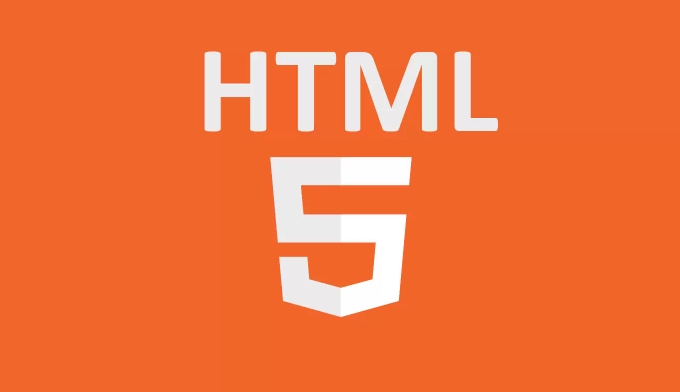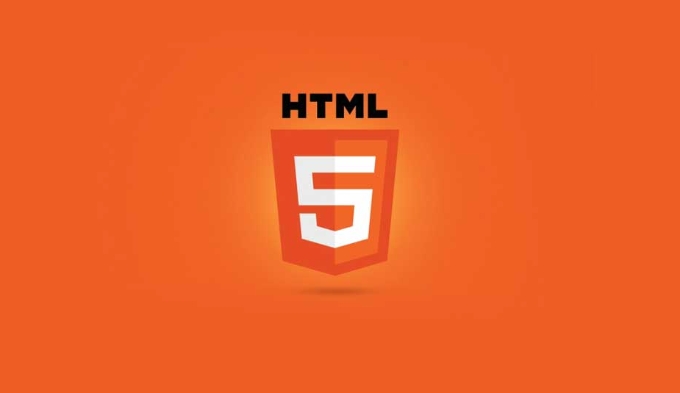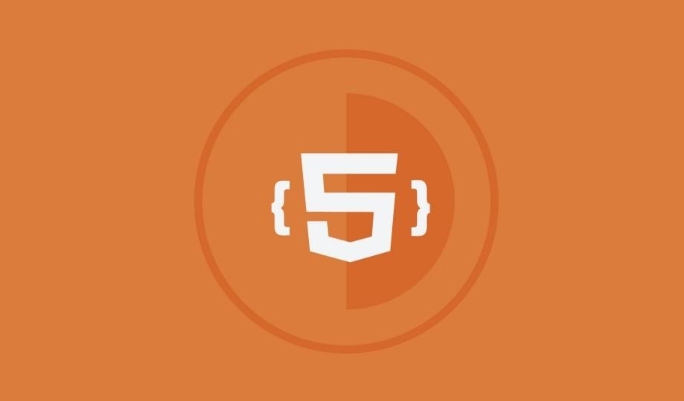Key Technical Differences: HTML vs HTML5
Jul 13, 2025 am 01:21 AMThe main differences between HTML5 compared to original HTML are reflected in four aspects: First, the introduction of semantic tags, such as

When people talk about HTML vs HTML5, what they're really asking is: what's different between the original HTML and its updated version, HTML5? The short answer is that HTML5 brings a bunch of new features, cleaner code, and better support for multimedia and mobile — things today's web just wouldn't work without.

1. Structural Tags – More Meaningful Layouts
Older versions of HTML mostly relied on <div> tags with class or id names to structure a page — like <code><div id="header"> or <code><div class="footer"> . That worked, but it wasn't very descriptive.<p> HTML5 introduced <strong>semantic elements</strong> like <code><header></header> , <footer></footer> , <nav></nav> , <article></article> , and <section></section> . These aren't just cosmetic — they help browsers, screen readers, and search engines understand the layout better.

For example:
-
<nav></nav>clearly marks where the navigation menu is. -
<article></article>tells the browser this is a self-contained piece of content.
This makes coding easier and improves accessibility and SEO without extra effort.

2. Native Multimedia Support – No Plugins Needed
In classic HTML, if you wanted to embed audio or video, you had to use third-party plugins like Flash — which was clunky, insecure, and not mobile-friendly.
HTML5 changed the game by introducing native support through:
-
<audio></audio>tag for sound files -
<video></video>tag for videos
You can now do something like:
<video src="movie.mp4" controls></video>
And the browser handles playback without needing extra software. This was a big deal when mobile browser took off since most mobile devices never supported Flash.
3. Better Form Handling and Input Types
Forms in older HTML were pretty basic. You had <input type="text"> , <input type="password"> , and maybe a few others. If you wanted date pickers, email validation, or numeric inputs, you needed JavaScript or external libraries.
HTML5 added new input types like:
-
<input type="email"> -
<input type="date"> -
<input type="number"> -
<input type="range">(slider) -
<input type="color">
These make forms smarter. For example:
- Using
type="email"on a mobile device will bring up an email-optimized keyboard. - Browsers can validate fields automatically without custom scripts.
Also, HTML5 introduced attributes like placeholder , required , and autofocus , making forms more user-friendly out of the box.
4. Improved Error Handling and Doctype
HTML used to be pretty forgiving, sometimes too much. Different browsers could interpret broken code differently, leading to inconsistent layouts.
HTML5 doesn't fix all rendering quirks, but it simplified the doctype declaration , which tells the browser how to render the page. In old HTML, it looked like this:
<!DOCTYPE html PUBLIC "-//W3C//DTD XHTML 1.0 Transitional//EN" "http://www.w3.org/TR/xhtml1/DTD/xhtml1-transitional.dtd">
In HTML5, it's much simpler:
<!DOCTYPE html>
That one line tells the browser to render in standards mode — no confusion, no long URLs. It also improved parsing rules so browsers handle bad code more consistently.
Final Thoughts
So, what's the real difference between HTML and HTML5? It's not just a name change — HTML5 modernized the language to match how we use the web today. With semantic tags, native media support, smarter forms, and cleaner syntax, it made development faster and websites more capable.
It's not complicated once you start using it, but those small differences add up in a big way.
The above is the detailed content of Key Technical Differences: HTML vs HTML5. For more information, please follow other related articles on the PHP Chinese website!

Hot AI Tools

Undress AI Tool
Undress images for free

Undresser.AI Undress
AI-powered app for creating realistic nude photos

AI Clothes Remover
Online AI tool for removing clothes from photos.

Clothoff.io
AI clothes remover

Video Face Swap
Swap faces in any video effortlessly with our completely free AI face swap tool!

Hot Article

Hot Tools

Notepad++7.3.1
Easy-to-use and free code editor

SublimeText3 Chinese version
Chinese version, very easy to use

Zend Studio 13.0.1
Powerful PHP integrated development environment

Dreamweaver CS6
Visual web development tools

SublimeText3 Mac version
God-level code editing software (SublimeText3)

Hot Topics
 Building Immutable Objects in PHP with Readonly Properties
Jul 30, 2025 am 05:40 AM
Building Immutable Objects in PHP with Readonly Properties
Jul 30, 2025 am 05:40 AM
ReadonlypropertiesinPHP8.2canonlybeassignedonceintheconstructororatdeclarationandcannotbemodifiedafterward,enforcingimmutabilityatthelanguagelevel.2.Toachievedeepimmutability,wrapmutabletypeslikearraysinArrayObjectorusecustomimmutablecollectionssucha
 Building RESTful APIs in Java with Jakarta EE
Jul 30, 2025 am 03:05 AM
Building RESTful APIs in Java with Jakarta EE
Jul 30, 2025 am 03:05 AM
SetupaMaven/GradleprojectwithJAX-RSdependencieslikeJersey;2.CreateaRESTresourceusingannotationssuchas@Pathand@GET;3.ConfiguretheapplicationviaApplicationsubclassorweb.xml;4.AddJacksonforJSONbindingbyincludingjersey-media-json-jackson;5.DeploytoaJakar
 A Developer's Guide to Maven for Java Project Management
Jul 30, 2025 am 02:41 AM
A Developer's Guide to Maven for Java Project Management
Jul 30, 2025 am 02:41 AM
Maven is a standard tool for Java project management and construction. The answer lies in the fact that it uses pom.xml to standardize project structure, dependency management, construction lifecycle automation and plug-in extensions; 1. Use pom.xml to define groupId, artifactId, version and dependencies; 2. Master core commands such as mvnclean, compile, test, package, install and deploy; 3. Use dependencyManagement and exclusions to manage dependency versions and conflicts; 4. Organize large applications through multi-module project structure and are managed uniformly by the parent POM; 5.
 css dark mode toggle example
Jul 30, 2025 am 05:28 AM
css dark mode toggle example
Jul 30, 2025 am 05:28 AM
First, use JavaScript to obtain the user system preferences and locally stored theme settings, and initialize the page theme; 1. The HTML structure contains a button to trigger topic switching; 2. CSS uses: root to define bright theme variables, .dark-mode class defines dark theme variables, and applies these variables through var(); 3. JavaScript detects prefers-color-scheme and reads localStorage to determine the initial theme; 4. Switch the dark-mode class on the html element when clicking the button, and saves the current state to localStorage; 5. All color changes are accompanied by 0.3 seconds transition animation to enhance the user
 css dropdown menu example
Jul 30, 2025 am 05:36 AM
css dropdown menu example
Jul 30, 2025 am 05:36 AM
Yes, a common CSS drop-down menu can be implemented through pure HTML and CSS without JavaScript. 1. Use nested ul and li to build a menu structure; 2. Use the:hover pseudo-class to control the display and hiding of pull-down content; 3. Set position:relative for parent li, and the submenu is positioned using position:absolute; 4. The submenu defaults to display:none, which becomes display:block when hovered; 5. Multi-level pull-down can be achieved through nesting, combined with transition, and add fade-in animations, and adapted to mobile terminals with media queries. The entire solution is simple and does not require JavaScript support, which is suitable for large
 How to use Java MessageDigest for hashing (MD5, SHA-256)?
Jul 30, 2025 am 02:58 AM
How to use Java MessageDigest for hashing (MD5, SHA-256)?
Jul 30, 2025 am 02:58 AM
To generate hash values using Java, it can be implemented through the MessageDigest class. 1. Get an instance of the specified algorithm, such as MD5 or SHA-256; 2. Call the .update() method to pass in the data to be encrypted; 3. Call the .digest() method to obtain a hash byte array; 4. Convert the byte array into a hexadecimal string for reading; for inputs such as large files, read in chunks and call .update() multiple times; it is recommended to use SHA-256 instead of MD5 or SHA-1 to ensure security.
 python parse date string example
Jul 30, 2025 am 03:32 AM
python parse date string example
Jul 30, 2025 am 03:32 AM
Use datetime.strptime() to convert date strings into datetime object. 1. Basic usage: parse "2023-10-05" as datetime object through "%Y-%m-%d"; 2. Supports multiple formats such as "%m/%d/%Y" to parse American dates, "%d/%m/%Y" to parse British dates, "%b%d,%Y%I:%M%p" to parse time with AM/PM; 3. Use dateutil.parser.parse() to automatically infer unknown formats; 4. Use .d
 VSCode settings.json location
Aug 01, 2025 am 06:12 AM
VSCode settings.json location
Aug 01, 2025 am 06:12 AM
The settings.json file is located in the user-level or workspace-level path and is used to customize VSCode settings. 1. User-level path: Windows is C:\Users\\AppData\Roaming\Code\User\settings.json, macOS is /Users//Library/ApplicationSupport/Code/User/settings.json, Linux is /home//.config/Code/User/settings.json; 2. Workspace-level path: .vscode/settings in the project root directory






